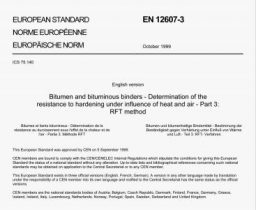En 292 1 Pdf Free Download
EN 292-1-1991 pdf download.Safety of machinery — Basic concepts, general principles for design — Part 1: Basic terminology, methodology.
3.23.2 Enabling (control) device
Additional manually operated control device used in conjunction with a start control and which, when continuously actuated. allows a machine to function.
3.23.3 Hold-to-run control device
Control device which initiates and maintains operation of machine elements only as long as the manual control (actuator) is actuated. The manual control (actuator) returns automatically to the stop position when released.
3.23.4 Two-hand control device Hold-to-run control device which requires at least the simultaneous actuation of two manual controls (actuators) in order to trigger and to maintain operation of the machine or machine elements, thus affording a measure of protection for the person operating the manual controls (actuators).
3.23.5 Trip device
Device which causes a machine or machine elements to stop (or ensures an otherwise safe condition) when a person or a part of his body goes beyond a safe limit.
Trip devices may be:
— mechanically actualed: e.g. trip wires, telescopic probes, pressure sensitive devices, etc.,
— non-mechanically actuaLed: e.g. photo-electric devices, devices using capacitive, ultrasonic, etc. means to achieve detection.
3.23.6 Mechanical restraint device
Device which introduces into a mechanism a mechanical obstacle (wedge, spindle, strut, scotch, etc.) which, by virtue of its own strength, can prevent any hazardous movement (for instance, the fall of a ram due to the failure of the normal retaining system).
3.23.7 Limiting device
Device which prevents a machine or machine elements from exceeding a designed limit (e.g. space limit, pressure limit, etc.).
3.23.8 Limited movement control device
Control device, the actuation of which permits only a limited amount of travel of a machine element, thus minimizing risk as much as possible; further movement is precluded until there is a subsequent and separate actuation of the control.
3.24 Deterring/impeding device
Any physical obstacle which, without totally preventing access to a danger zone, reduces the probability of access to this zone by offering an obstruction to free access.
4 Description of hazards generated by
machinery
4.1 General
The lurlose of this clause is to identify and to describe (by their nature or by their consequences) the various hazards which machinery is likely to generate, in order to facilitate the hazard analysis which is to be carried out, in irnrticular:
— when designing a machine,
— when working out a safety standard relating to
a machine,
— when assessing risk.
4.2 Mechanical hazard
Mechanical hazard is a general designation for all physical factors which may give rise to injury due to the mechanical action of machine parts, tools, workpieces or of projected solid or fluid materials.
4.2.1 The elementary forms of mechanical hazard are notably:
— crushing hazard,
— shearing hazard,
— cutting or severing hazard,
— entanglement hazard,
— drawing-in or trapping hazard.
— impact hazard,
— stabbing or puncture hazard,
— friction or abrasion hazard.
— high pressure fluid ejection hazard.
4.2.2 The mechanical hazard which may be generated by machine parts (or workpieces) is conditioned, among other factors, by:
— shape: cutting elements, Shari) edges, angular
parts, even if they are motionless,
— relative location, which may create crushing,
shearing, entanglement, etc. zones, when they
are moving,
— mass and stability (potential energy of
elements which may move under the effect of
gravity),
— mass and velocity (kinetic energy of elements
in controlled or uncontrolled motion),
— acceleration,
— inadequate mechinical strength, which may
generate hazardous breakages or bursts,
— potential energy of elastic elements (springs),
or of liquids or gases under pressure or vacuum.
4.2.3 Because of their mechanical nature, slip, trip and falling hazards in relationship with machinery are also included in subclause 4.2.
4.3 Electrical hazard
This hazard may cause injury or death from electric shock, or burn; these may be caused:
by contact of persons with:
• live parts. i.e. parts which normally carry a voltage (direct contact);
• parts which have become live under fault conditions, especially as a result of an
insulation failure (indirect contact);
by approach of persons to live parts, especially in the range of high voltage;
— by insulation not suitable for foreseeable conditions of use;
— by electrostatic phenomena such as contact of persons with charged parts;
— by thermal radiation or phenomena, such as projection of molten particles, and chemical
effects from short-circuits, overloads, etc.
It may also cause falls of persons (or of objects dropped by persons) as a result of the surprise induced by electric shock.
4.4 Thermal hazard
Thermal hazard may result in:
— burns and scalds, from contact with objects or
materials with an extreme temperature, flames
or explosions and radiation from heat sources,
— hecilth-dainaging effects generated by hot or
cold work environment.EN 292-1-1991 pdf download.
PS:Thank you for your support!
- Safety of machinery
 BS Standards
BS Standards BS EN 12607-3-2000 pdf download.Methods of test for petroleum and its products — BS 2000-460.3: Bitumen and bituminous binders — Determination of the resistance to hardening under the influence of heat and air — Part 3: RFT...
08-15
 BS Standards
BS Standards BS EN 12329-2000 pdf download.Corrosion protection of metals — Electrodeposited coatings of zinc with supplementary treatment on iron or steel. This BS EN 12329 specifies requirements for electrodeposited coatings of zinc on iron or steel witt supplementary...
08-15
 BS Standards
BS Standards BS EN 1430-2000 pdf download.Methods of test for petroleum and its products — BS 2000-292:Bitumen and bituminous binders — Determination of particle polarity of bitumen emulsions (Identical with IP 292-2000). This BS EN 1430 specifies a method...
08-15
Source: https://www.freestandardsdownload.com/en-292-1-1991-pdf-download.html
Post a Comment for "En 292 1 Pdf Free Download"